10 Best Carnivorous Plants to Grow in 2024: Easy Care Tips and Top Picks
- April 23, 2024
- 0 comment
Discover the 10 best carnivorous plants to grow in 2024! Find easy care tips and best picks for stunning, low-maintenance additions to your garden. Dive into the world of carnivorous plants with our guide to the 10 best species to cultivate in 2024. These extraordinary plants offer more than just aesthetic appeal; they provide a practical, low-effort gardening solution. From the well-known Venus Flytrap to the exotic allure of the Pitcher Plant, our curated selection promises ease and success in care.
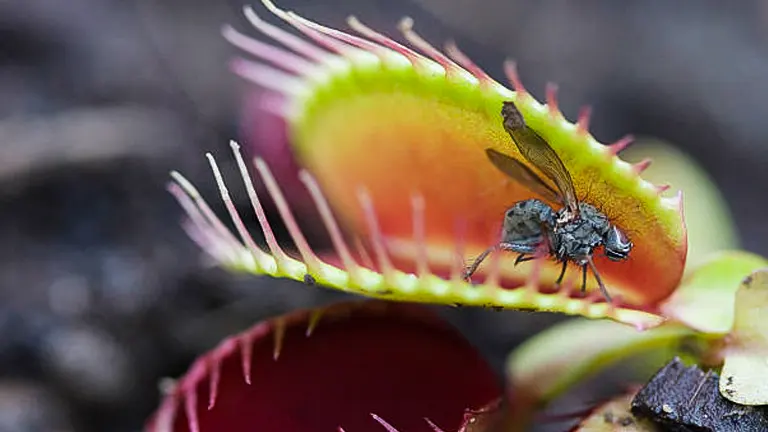
Perfect for both expert gardeners and beginners, these intriguing plants are guaranteed to enhance your garden’s charm. Continue reading for essential care tips and prepare to be captivated by these natural wonders.
List of 10 Best Carnivorous Plants to Grow in 2024
- Venus Flytrap (Dionaea muscipula)
- Sundew (Drosera)
- Pitcher Plant (Nepenthes)
- Butterwort (Pinguicula)
- Bladderwort (Utricularia)
- Cobra Lily (Darlingtonia californica)
- Waterwheel Plant (Aldrovanda vesiculosa)
- North American Pitcher Plant (Sarracenia)
- Brocchinia Reducta
- Australian Pitcher Plant (Cephalotus follicularis)
Understanding Carnivorous Plants
Definition and Unique Characteristics
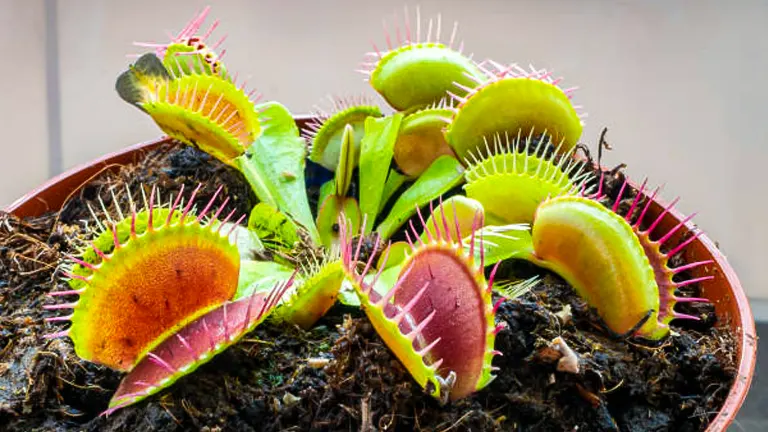
Carnivorous plants are nature’s ingenious solution to survival in nutrient-deficient soils. Through evolution, they have developed specialized mechanisms to lure, capture, and digest prey, primarily insects and other small arthropods, to obtain essential nutrients such as nitrogen, phosphorus, and potassium. Unlike other flora, carnivorous plants have active or passive trapping mechanisms that are not just about defense but are central to their nutrition. These mechanisms include:
- Snap Traps: Exemplified by the Venus Flytrap, snap traps use rapid leaf movements to capture prey.
- Pitfall Traps: Plants like the Pitcher Plant have evolved leaves into deep, slippery cavities filled with digestive enzymes.
- Flypaper Traps: Sticky glandular hairs on plants such as Sundews (Drosera) immobilize insects upon contact.
- Suction Traps: Aquatic Bladderworts (Utricularia) use bladder-like structures to create a vacuum, sucking in prey when triggered.
- Lobster-Pot Traps: Certain species, like the Genlisea, or corkscrew plants, guide prey into a one-way trap with inward-pointing hairs.
These diverse trapping strategies are not only a testament to the adaptability of carnivorous plants but also highlight the complexity of their evolutionary journey.
Environmental and Ecological Impact
Carnivorous plants play a unique role in their ecosystems. They often inhabit boggy, marshy, or aquatic environments where the soil lacks sufficient nutrients for most plant life. By controlling insect populations, they contribute to the ecological balance, preventing any single species from becoming overly dominant. Their presence also supports a range of species-specific mutualisms, such as providing habitats for certain insects that, in turn, help to pollinate the plants or protect them from herbivores.
Benefits of Growing Carnivorous Plants
Beyond their fascinating biology, carnivorous plants offer several benefits when incorporated into home gardens or indoor plant collections:
- Natural Pest Control: By capturing common garden pests, they reduce the reliance on chemical insecticides, promoting a more organic approach to gardening.
- Aesthetic and Educational Value: The exotic appearance of carnivorous plants, with their unique traps and vibrant flowers, adds a distinctive beauty to any setting. They serve as living laboratories, offering insights into evolutionary biology, plant anatomy, and the intricacies of ecological interactions, thus fostering a deeper appreciation for the natural world.
- Conservation Awareness: Cultivating and learning about these plants can raise awareness of their conservation status. Many species are threatened by habitat destruction, pollution, and climate change. Through responsible cultivation, enthusiasts can contribute to the preservation of these remarkable species and their natural habitats.
Cultivation as a Hobby
The cultivation of carnivorous plants has grown into a vibrant hobby, supported by a dedicated community of enthusiasts and specialized nurseries. It offers an engaging challenge, requiring specific care and conditions, but the reward lies in witnessing the dynamic and often dramatic life cycle of these plants. From germinating seeds to observing the sophisticated trapping and digestion process, growing carnivorous plants can be a deeply satisfying endeavor that connects hobbyists with the intricacies of the natural world.
Top 10 Carnivorous Plants to Grow in 2024
1. Venus Flytrap (Dionaea muscipula)
The Venus Flytrap is famously known for its jaw-like leaves that snap shut swiftly when the fine hairs inside are triggered by an unsuspecting insect. This rapid movement is facilitated by changes in internal water pressure, allowing the trap to close in a fraction of a second. Native to the subtropical wetlands of the East Coast of the United States, this plant’s vivid green and sometimes red-tinged leaves make it a striking addition to any collection.
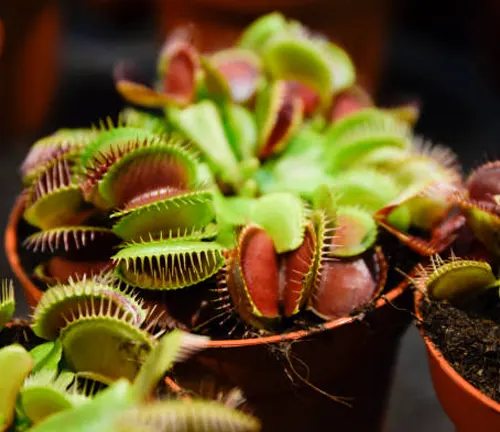
- Trap Type: Snap trap
- Best Time to Plant: Early spring, to coincide with the start of its active growth period.
- Watering: Distilled or rainwater only; keep the soil consistently moist.
- Light: Full sun for at least 4-6 hours a day.
- Soil: Nutrient-poor, acidic soil such as a mixture of sphagnum peat moss and perlite.
- Temperature: Ideal temperatures are 70-95°F (21-35°C); requires winter dormancy at 35-55°F (1.5-13°C).
- Feeding: Feed small insects every 2-4 weeks during the growing season.
2. Sundew (Drosera)
Sundews capture their prey with sticky, glandular trichomes on their leaves that attract and ensnare insects. These fascinating plants are covered in delicate, dew-like droplets that glisten in the sunlight to lure their meals closer. Depending on the species, Sundews can vary significantly in size and form, from tall, slender leaves to tight, colorful rosettes.
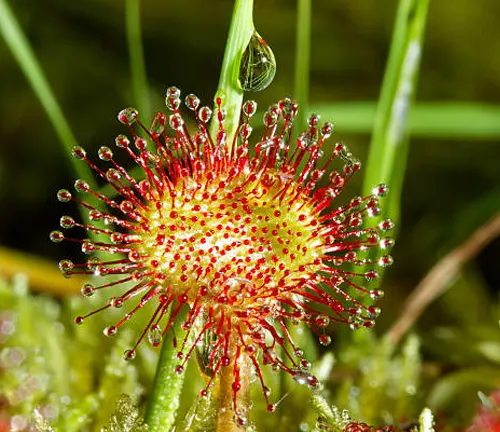
- Trap Type: Flypaper trap
- Best Time to Plant: Spring, as new growth emerges.
- Watering: Keep the soil wet at all times; use distilled or rainwater.
- Light: Full to partial sunlight.
- Soil: Acidic, poor in nutrients; use a peat and sand mix.
- Temperature: Varies by species, generally prefers cooler night temperatures.
- Feeding: No need to manually feed; insects will naturally be attracted to the sticky leaves.
3. Pitcher Plant (Nepenthes)
Pitcher Plants feature elaborate modified leaves known as pitchers that act as pitfall traps, filled with a digestive fluid where insects drown and are digested. These tropical plants are visually striking, often bearing pitchers of varying colors and sizes suspended from tendrils, making them a dramatic hanging addition to any space.
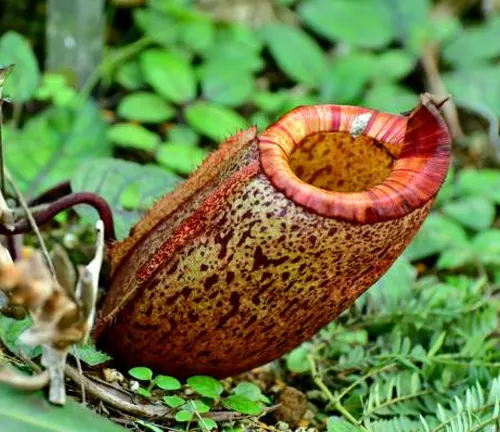
- Trap Type: Pitfall trap
- Best Time to Plant: Early spring or when temperatures consistently stay above 50°F (10°C).
- Watering: Keep the soil moist; do not let dry out.
- Light: Bright, indirect light.
- Soil: Nutrient-poor, well-draining; use sphagnum moss and perlite.
- Temperature: Keep at 60-80°F (15-27°C); some highland species prefer cooler temperatures.
- Feeding: Occasionally feed with small insects if not catching enough naturally.
4. Butterwort (Pinguicula)
Butterworts utilize their sticky, flat leaves to trap insects, making them an excellent choice for controlling flying pests. These plants are not only functional but also bloom with beautiful, often vibrant flowers that contrast their typically green or purple tinted leaves.
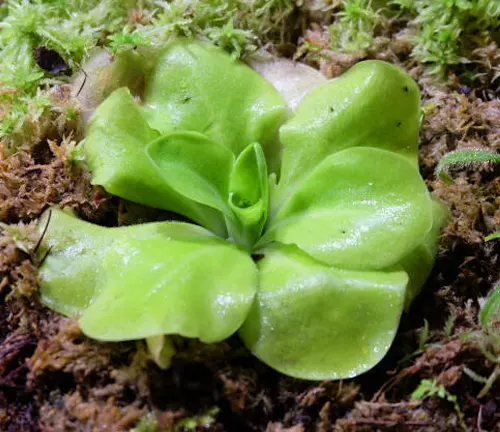
- Trap Type: Flypaper trap
- Best Time to Plant: Spring, as they exit winter dormancy.
- Watering: Allow the surface to dry slightly between watering; use distilled or rainwater.
- Light: Moderate to bright, indirect light.
- Soil: Mix of peat and perlite or pure sphagnum moss.
- Temperature: Prefer cooler temperatures, ideally 50-70°F (10-21°C).
- Feeding: Feed small insects occasionally; not required frequently.
5. Bladderwort (Utricularia)
Bladderworts are unique among carnivorous plants in that they have no roots and use underwater bladder traps to capture tiny water creatures. These fast-acting traps use a vacuum mechanism to suck in prey at remarkable speeds. Bladderworts are usually found in freshwater habitats and are highly effective at controlling mosquito larvae.
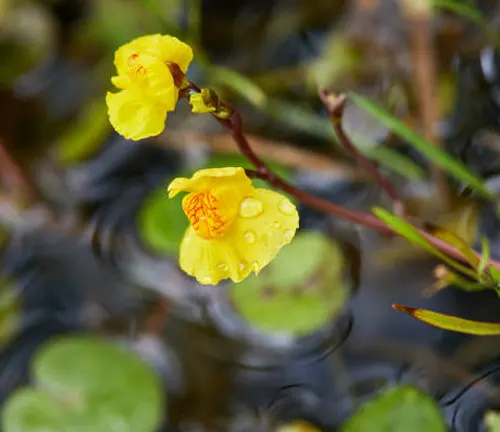
- Trap Type: Suction trap
- Best Time to Plant: Early spring, in water bodies with full sun exposure.
- Watering: Aquatic environment; ensure water is clean and nutrient-poor.
- Light: Full sun to partial shade.
- Soil: None needed; free-floating or anchored in very wet soil.
- Temperature: Varies widely, generally prefers 50-75°F (10-24°C).
- Feeding: No feeding necessary; traps microscopic aquatic organisms.
6. Cobra Lily (Darlingtonia californica)
Cobra Lily, also known as the California Pitcher Plant, is unique because it traps insects not with a sticky substance or a snap trap but with a cunning pitfall trap. The plant’s serpentine pitchers resemble a striking cobra poised to strike, complete with a forked leaf resembling a tongue. This species thrives in cool, running water and is native to Northern California and Oregon, making it a spectacular and unusual addition to any carnivorous plant collection.
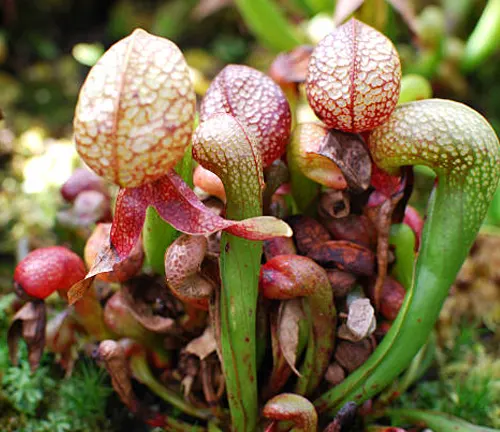
- Trap Type: Pitfall trap
- Best Time to Plant: Spring, when the risk of frost has passed and natural water flow is re-established.
- Watering: Keep the roots cool with constant, flowing water.
- Light: Partial shade; too much sunlight can overheat the plant.
- Soil: Non-nutritive, acidic soil (pure sphagnum is ideal).
- Temperature: Prefers cooler temperatures, ideally below 75°F (24°C).
- Feeding: Rarely needs feeding; insects naturally fall victim to its deceptive design.
7. Waterwheel Plant (Aldrovanda vesiculosa)
The Waterwheel Plant is a rootless aquatic species that captures prey with rapid snap-trap mechanisms, similar to those of the Venus Flytrap but underwater. This rare plant moves with such speed that it can snap shut in milliseconds, trapping tiny aquatic invertebrates. It’s fascinatingly mobile, drifting freely in the water, which makes it a dynamic component of any aquatic carnivorous plant setup.
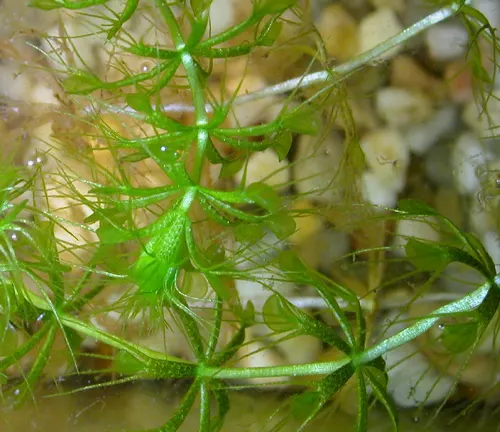
- Trap Type: Snap trap
- Best Time to Plant: Early spring, in a stable aquatic environment.
- Watering: Submerged in mineral-poor, slightly acidic water.
- Light: Full to partial sunlight.
- Soil: No soil needed; free-floating.
- Temperature: Best kept at 60-75°F (15-24°C).
- Feeding: Does not require feeding; captures small aquatic invertebrates.
8. North American Pitcher Plant (Sarracenia)
Sarracenia, or North American Pitcher Plants, are characterized by their tall, funnel-shaped pitchers that lure insects into a watery grave. These plants are not only a gardener’s ally in pest control but also a botanist’s dream due to their vibrant colors and intricate patterns. Each pitcher is lined with fine hairs that direct unsuspecting insects downwards, preventing their escape.
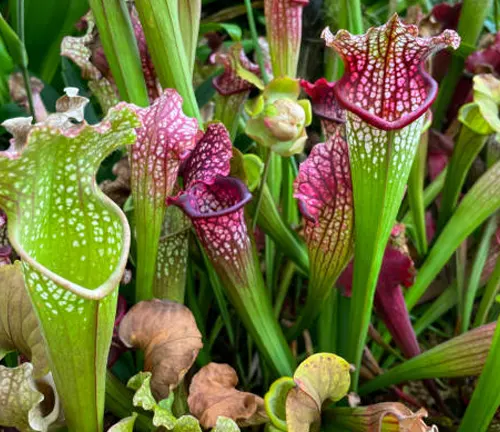
- Trap Type: Pitfall trap
- Best Time to Plant: Early spring, post-frost for outdoor setups.
- Watering: Keep the soil consistently moist but not waterlogged.
- Light: Full sun to maintain health and color vibrancy.
- Soil: Peat-sand mix, low in nutrients.
- Temperature: Thrives in 50-90°F (10-32°C); some species require winter dormancy.
- Feeding: Feeding is not necessary but can boost growth if natural insect supply is low.
9. Brocchinia Reducta
Brocchinia Reducta is a rare, carnivorous bromeliad with slick, water-collecting leaves that trap insects. This plant uses a passive pitfall trap mechanism, where it secretes a slippery substance that causes insects to slide into the central water-filled cup where they drown. Native to South America, its bright yellow-green coloration and pineapple-like appearance make it visually appealing.
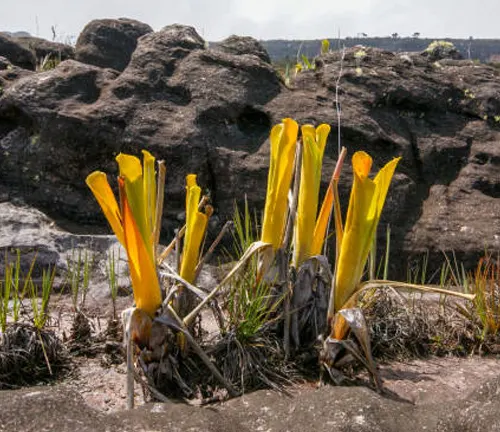
- Trap Type: Pitfall trap
- Best Time to Plant: Early to mid-spring.
- Watering: Maintain high humidity and moist conditions within the cup.
- Light: Bright, indirect light.
- Soil: Well-draining, nutrient-poor medium.
- Temperature: Prefers warmer climates, 70-85°F (21-29°C).
- Feeding: Minimal feeding required; traps small insects and debris.
10. Australian Pitcher Plant (Cephalotus follicularis)
The Australian Pitcher Plant features small, mottled pitchers that are as deadly as they are beautiful. The intricate structure of these pitchers includes a lid that prevents excessive rainwater from diluting the digestive enzymes within. This plant is not only a curiosity due to its compact size and the rarity outside its native Western Australia but also because of its effectiveness in capturing and digesting insects.
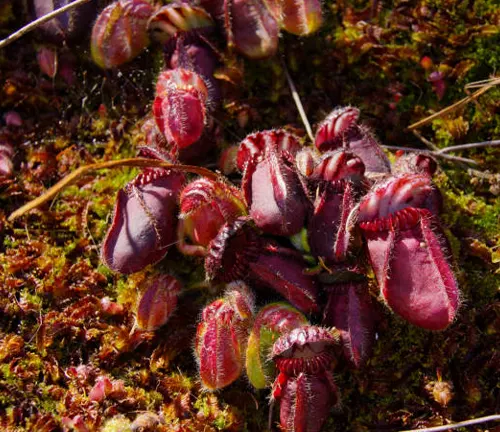
- Trap Type: Pitfall trap
- Best Time to Plant: Spring, when temperatures are mild.
- Watering: Regularly to keep the soil moist; use distilled water or rainwater.
- Light: Prefers partial shade to full sun.
- Soil: Acidic, low-nutrient; peat and perlite mix is ideal.
- Temperature: Best between 60-75°F (15-24°C).
- Feeding: Occasionally supplement with small insects if not adequately catching prey.
Essential Care for Thriving Carnivorous Plants
Cultivating carnivorous plants successfully requires a deep understanding of their native habitats—poor in nutrients but often damp. To replicate these conditions at home and encourage your plants to thrive, consider the following integrated care strategies:
Hydration Techniques and Soil Composition
Water quality is paramount; use only distilled, rainwater, or reverse osmosis water to mimic the pure rainfall these plants would receive in the wild. Regular watering should maintain consistent moisture, but avoid saturating the soil, which can lead to fungal diseases and root rot.
For soil, a mix of sphagnum peat moss and perlite or coarse sand will provide the low-nutrient content and excellent drainage these plants require. Avoid any soil mix with added fertilizers or compost, as the high nutrient content can suppress the natural functioning of the plants’ traps and may even be toxic to them.
Sunlight and Seasonal Adjustments
Providing sufficient sunlight is crucial; most carnivorous plants need a full sun exposure for 4-6 hours daily. During winter or in generally darker environments, supplement with LED or fluorescent grow lights to provide enough light for photosynthesis and trap development.
Adapt your care regimen with the seasons: reduce watering in the dormant winter months to prevent root issues, and resume more frequent hydration in spring as new growth appears.
Overcoming Common Cultivation Challenges
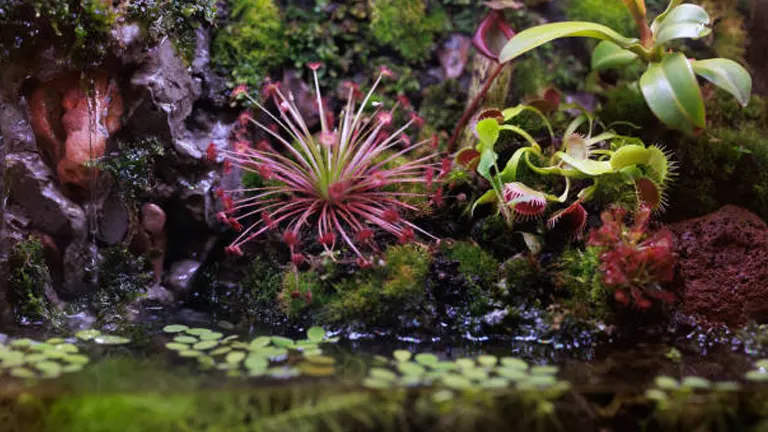
Caring for carnivorous plants often presents unique hurdles, particularly related to pests and plant health. Being proactive and informed can help you mitigate these issues effectively.
Pest Management
Carnivorous plants, with their moist and nutrient-rich traps, can become hotspots for pest infestations. Here’s how to handle common pests:
- Aphids and Spider Mites:
- Identification: Watch for small clusters of insects or mites, and webbing on plant traps.
- Treatment: Spray with diluted insecticidal soap or neem oil every other week until the infestation subsides.
- Prevention: Regularly inspect plants and isolate new additions to the collection to prevent spread.
- Fungus Gnats:
- Identification: Small black flies around the soil surface or base of the plant.
- Treatment: Use yellow sticky traps to catch adults and apply Bacillus thuringiensis var. israelensis (BTI) to the soil to kill larvae.
- Prevention: Allow the top layer of soil to dry out between waterings to discourage gnat reproduction.
Nutritional Management
Feeding carnivorous plants can be tricky, especially indoors where natural prey is scarce. Here’s how to feed them safely:
- Frequency and Size:
- General Rule: Feed one large or a few small insects per month during the growing season. Do not feed during dormancy.
- Prey Size: Ensure prey is no larger than a third of the trap’s size to prevent decay and mold.
- Supplemental Feeding:
- Method: Use tweezers to gently place the insect into the trap, stimulating the natural motion to close.
- Type of Insect: Prefer small flies, ants, or beetles that are commonly found in household environments.
Root Health and Environmental Care
Root rot and improper environmental conditions can severely impact the health of carnivorous plants:
- Root Rot Prevention:
- Symptoms: Soft, brown roots, and a wilting plant are early signs of root rot.
- Solutions: Ensure good drainage in pots, use clean containers, and sterile potting mix to prevent issues. If root rot is suspected, repot the plant into fresh, appropriate medium and trim any rotten roots.
- Optimizing Environmental Conditions:
- Humidity and Temperature: Most carnivorous plants prefer humidity levels of 50-70% and cooler temperatures around 70°F (21°C). Use a humidity tray or a small humidifier to maintain ideal conditions.
- Light Requirements: Provide partial to full sunlight, adjusting exposure based on the plant species and local climate conditions.
Related Post
- How to Fertilize a Mango Tree Effectively: Tips and Tricks for Healthy Growth
- How to Fertilize Apple Trees: Essential Tips for a Bountiful Harvest
- How to Fertilize Lemon Trees: Secrets for Thriving Citrus
- How to Fertilize Avocado Tree: A Step-by-Step Guide for Lush Growth
- How to Fertilize Bougainvillea: A Complete Guide for Stunning Blooms
Conclusion
Carnivorous plants are more than just an unusual collection of flora; they are a dynamic and interactive part of natural biodiversity. They offer an engaging, educational, and environmentally beneficial hobby that can captivate people of all ages. By understanding and respecting these plants’ unique needs and characteristics, gardeners can enjoy the myriad benefits they provide. Whether for pest control, education, or simple aesthetic value, carnivorous plants make a fascinating addition to any indoor or outdoor space.
FAQs
- What are some beginner-friendly carnivorous plants to start with in 2024?
Beginner-friendly options include the Venus Flytrap (Dionaea muscipula), various Sundews (Drosera species), and the North American Pitcher Plant (Sarracenia species). These plants are relatively hardy and require straightforward care, making them perfect for novices. - How often should I water my carnivorous plants?
Carnivorous plants generally thrive in consistently moist conditions. Water them with distilled, rain, or reverse osmosis water to keep the soil damp but not waterlogged. During the active growing season, ensure the soil never dries out completely. - Do carnivorous plants really need feeding, and if so, what should I feed them?
While carnivorous plants can obtain nutrients from their soil, feeding them small insects can promote healthier growth and more robust traps. Feed them small flies, ants, or spiders every few weeks during the growing season. Avoid feeding meat or cheese as these can rot and harm the plant. - Can I grow carnivorous plants indoors?
Yes, many carnivorous plants can thrive indoors if they receive enough light. Place them near a south-facing window or under a grow light to ensure they get at least four to six hours of sunlight daily. Keep the air around them humid and the soil consistently moist. - What is the best soil mixture for carnivorous plants?
The ideal soil mixture for most carnivorous plants is a blend of sphagnum peat moss and perlite or sand. This mix ensures good drainage and retains the necessary moisture without being nutrient-rich, which could harm the plants. - Are there any common diseases that affect carnivorous plants?
Carnivorous plants can suffer from fungal infections, especially if conditions are too wet without adequate ventilation. Root rot can also occur if the soil is waterlogged. Ensuring proper soil drainage and air circulation can help prevent these issues. - What are the lighting requirements for carnivorous plants?
Most carnivorous plants require direct sunlight for a significant part of the day. Those grown indoors may need artificial lighting to meet their photosynthesis needs. Ideally, provide 12 to 16 hours of light daily, mimicking the long days of summer, which encourages growth and health. - How can I replicate the humid conditions carnivorous plants love, especially indoors?
Increase humidity by placing a water tray near the plants, using a room humidifier, or keeping them in naturally humid areas like kitchens or bathrooms. Another method is to group plants together; this can create a microenvironment with higher humidity due to collective transpiration.
Explore the unique allure of carnivorous plants in 2024. With our top picks and easy care tips, you can effortlessly add these natural pest controllers to your garden or home. Enjoy cultivating these fascinating plants!

Benjamin Brooks
Forestry AuthorGreetings! I'm Benjamin Brooks, and my journey over the past 15 years has revolved around the fascinating realms of content creation, expertise in snow clearing, and the intricate world of lumberjacking and landscaping. What began as a simple curiosity about the natural world and heavy machinery has evolved into a passionate profession where my love for crafting words intertwines seamlessly with my lumberjacking and garden skills.




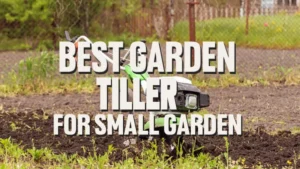




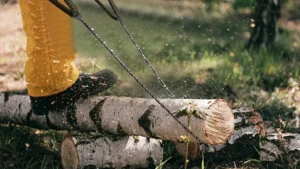



Leave your comment